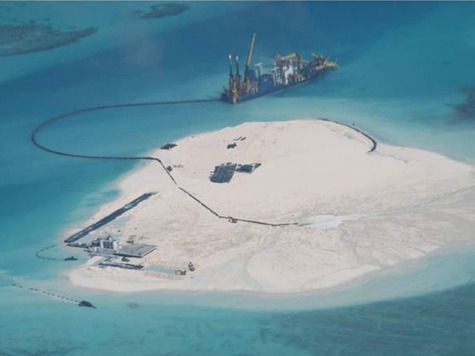The Chinese government has expanded its territorial claims in the South China Sea by building islands on reefs that both Vietnam and the Philippines claim are theirs, according to new reports. The islands, on the South Johnson Reef and the Spratly Islands, may one day serve as naval bases in waters that much of the world asserts are not China’s.
The New York Times reports that the Spratly Islands, largely consisting of uninhabitable reefs and nestled between Vietnam and the Philippines, have been home to some extensive construction by China. The islands appear only to have been created in the past several months and could serve as both military base and economic hotspot should China invoke United Nations international law. Officials told the paper that there appear to be “two or three” islands, and that at least one of them appears to have military purposes.
According to foreign officials speaking to the newspaper, the new islands “will be able to support large buildings, human habitation and surveillance equipment, including radar.” The Chinese government has said that China “has indisputable sovereignty” over the region, and has decried internationally attempts to keep it out of territory Vietnam and the Philippines contest is theirs. “China will not accept any arbitrary procedures in terms of sea boundaries and territorial disputes,” said Deputy Permanent Representative to the UN for China Wang Min this week, alleging that both China and Vietnam had lost their credibility within the eyes of the international community for their stance on the islands.
In May, the government of the Philippines warned of precisely this scenario: Chinese construction on South Johnson Reef. The Philippines alleged that the Chinese were building an airstrip in the area–not a complete island–but noted nonetheless that China did not have sovereign claim over the territory to construct such an airstrip. The Chinese government vehemently rejected the Philippines’ claim.
With Vietnam, tensions have been much more direct, due to the Chinese moving a giant oil rig into South China Sea waters that Vietnam claims is Vietnamese sovereign territory. The oil rig remained in the area, and Vietnam alleged that China had rammed one of its ships in an act of aggression related to the dispute. In response, China alleged that Vietnam had rammed Chinese ships 1,416 times. That allegation surfaced in an extensive report on the dispute that China presented to the United Nations.
The United States has remained mostly silent in these disputes, though President Obama has been vocally supportive of Japan in similar disputes in the East China Sea, and the United States recently signed a ten-year security deal with China. The Chinese government has expressed dismay at America’s potential involvement, warning that supporting the enemies of China could make the U.S. its “qualified enemy.” In March, it was revealed that tension with the United States was China’s deliberate goal: the Department of Defense unveiled in March China’s anti-U.S. “Three Warfares” strategy–targeting the U.S. through “psychological, media, and legal operations.”

COMMENTS
Please let us know if you're having issues with commenting.